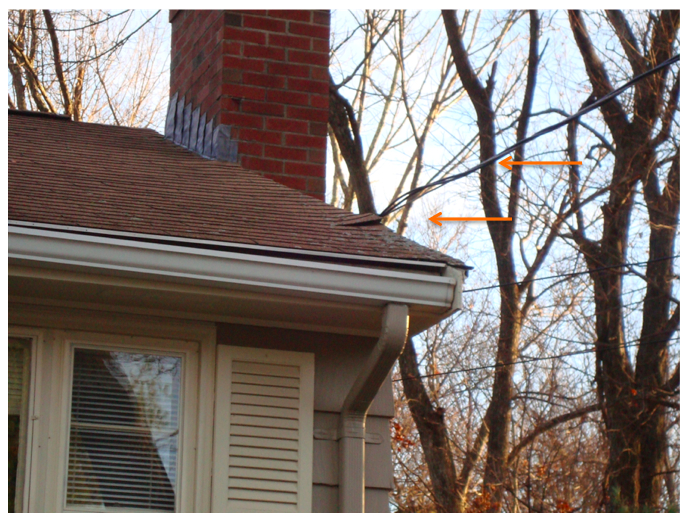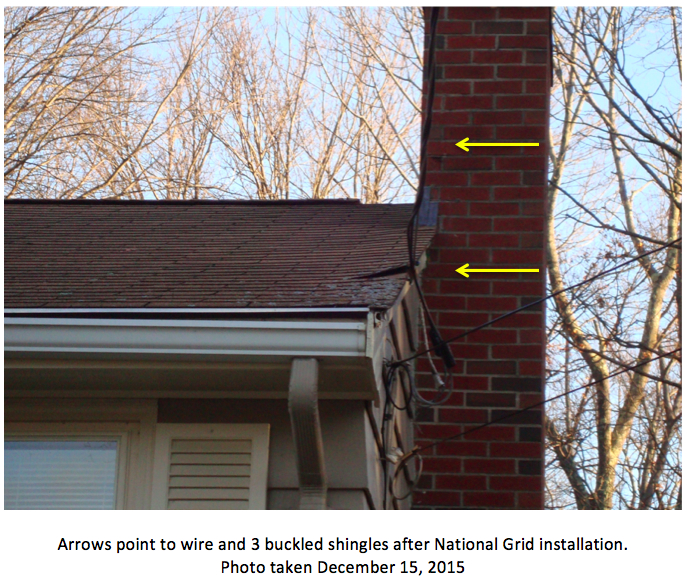TO:
Arthur Vigeant, Mayor
Robert Camacho, Building Commissioner
City of Marlborough
CC:
Marcy Reed, President
Ed White, Vice President
National Grid
FROM:
Jen Boudrie, Resident
DATE:
December 16, 2015
RE: National Grid Training Crew Uses Marlborough Homes as Training Sites
I saw this was done to my home and I caught it. How about residents in Marlborough whose homes are also being used as training sites for National Grid’s training crews? Attached is a photo and how I handled it. Please note the supervisor said this was acceptable and he pointed to a minor change to defend their work. I’m fortunate I work out of my house but most who work outside of the home will not know National Grid did anything to their homes. Is it possible to do a drive by to look at the work National Grid did to see if it meets the standards you would insist upon from any other private corporation or contractor?
Personal Experience and Recommendations to National Grid
Jen Boudrie, M.Ed.
Marlborough, MA
jenboudrie@gmail.com
December 16, 2015
December 7, Monday
I come home and find about ten men with trucks by my driveway. I ask what’s happening and the manager explains a training crew is changing electrical wires on my street. National Grid, he explains, is spending a lot of money to harden the grid infrastructure.
December 11, Friday
Someone knocks on my door and says electricity will go off 12:30‐1:15. I ask if he can do it at 1:00 instead because I’m leading a telephone conference call noon-1. He says no. I ask twice if it will disrupt my landline. He says no your telephone line will be fine.
Well, the telephone line dies at 12:30. The two men are kind enough to reconnect my electricity so I can finish the call, but it was a problem. I planned that 8-person teleconference weeks in advance and could not change it at the last minute. The two men clearly had some schedule flexibility. Disruption to my work and their work was avoidable.
RECOMMENDATION
Communicate with customers in advance and be reasonable with scheduling.
December 15, 2015
I notice National Grid changed the wiring from the street to our home while I was out. Shingles are buckled on the roof. A wire was originally on the right of the tree. Now it’s on the left. This is problematic:
- The new wire is under many more tree branches and more vulnerable during storms.
- It’s hazardous to have lines criss-crossing the property and over the middle of the front yard.
- The new wiring is next to roof shingles that buckled under the pressure. On windy days there will be chaffing and friction between the shingles and wiring. Over a decade the wiring could become frayed. This fire hazard is completely unacceptable.
See PHOTOS below.
RECOMMENDATIONS
The wire should be moved to its original position to the right of the tree near the other two wires. This solves several problems:
- There are fewer tree branches above the wire.
- Tree/ice/storm damage is less likely.
- Fewer wires are criss-crossing the property and the front yard.
- The shingles will not buckle.
- It eliminates chaffing and friction between the wiring and shingles – no fire hazard.
Called National Grid
The training crew is not in the neighborhood. I do not have their contact info. I do not know if they will come back. I go online to contact National Grid and called the obvious number: 1-800-465‐1212.
I explain a training crew installed a wire that is buckling a couple shingles on my roof and this is unacceptable. I did not say this was an emergency. A woman said an emergency crew would come to fix it. No one came.
RECOMMENDATION
Notify residents in advance about the work being done on their street and on their homes. Provide contact info and notice to each resident whose home is worked on.
December 16, 2015
The training crew shows up down the street, apparently not informed about my call to National Grid. I ask a crew leader to look at the wiring on my house. He agrees it should be fixed. I decide to observe the crew as they work.
Clearly the man on the ladder rewiring my house is unsure and unskilled. I ask a supervisor to come and observe him. The man on the ladder is not sure where to put the wires, is not skilled at baring the ends of wires with his knife, and is not able to use his tool well -‐ he has trouble holding it, using it, and replacing the battery which he says is not working well.
Clearly the man on the ladder wiring my house and the man in the bucket wiring on the street were well trained to use electrical tape. They were awkward with several things, but when they were nearly done, they whipped out their electrical tape and wrapped up wires and connections with finesse. One can only hope the tape was not really needed or will stand the test of time.
RECOMMENDATIONS
Trainees should pass a basic test with wires and tools before working on a house.
Trainees should be closely supervised on training sites.
Given the low experience/skill level of the trainees, National Grid experts should inspect work
1) while it is being performed
2) before leaving a job
3) after the job is completed
CONCLUSION
1) It is inappropriate to use residents’ homes as National Grid training sites without their knowledge.
2) Adequate training and supervision should be provided.
3) National Grid is spending $10 billion* to harden the infrastructure with changes like this? Replacing two wires with one and other changes of equally small consequence, AND poor workmanship are unethically wasteful and potentially hazardous on a large scale. This example of grid modernization** is costly window dressing with a great flourishing of electrical tape and has the potential of totally decimating funds promised for a smarter grid and a cleaner energy future for us all.
4) In other words, spend $10 billion of your customers’ money on good training, a smart grid, and clean energy.
* https://www.nationalgridus.com/aboutus/a3-1_news2.asp?document=8863
** http://www.mass.gov/eea/energy-utilities-clean-tech/electric-power/grid-mod/grid-modernization.html


